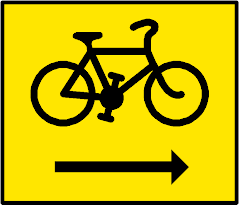 I've been at this bike commuting thing for roughly 5 years now. I think I can safely say I'm a fairly competent cyclist, seeing as how that adds up to somewhere north of 1000 days I've ridden my bike in the recent past. But accidents happen. And my first did a few weeks ago, as I recently alluded to. I wasn't hit by a car, wasn't doored, wasn't run over by an errant elephant. Nope. Something strange happened while I was all by myself and over I went.
I've been at this bike commuting thing for roughly 5 years now. I think I can safely say I'm a fairly competent cyclist, seeing as how that adds up to somewhere north of 1000 days I've ridden my bike in the recent past. But accidents happen. And my first did a few weeks ago, as I recently alluded to. I wasn't hit by a car, wasn't doored, wasn't run over by an errant elephant. Nope. Something strange happened while I was all by myself and over I went.Luckily I was moving pretty fast at the time and didn't have much time to react before I hit the ground. That kept me from getting my hand out to brace for impact (which invariably leads to a broken wrist or collarbone, and maybe serious elbow injury). Instead, I hit the fleshy parts . . . and that's a good thing (mostly).
Once upon a time I went through Army Airborne training. They spend two weeks teaching you how to fall, then the third week they push you out of the plane a few times to see if it took. The basics of falling are your points of contact: (1) Balls of your feet; (2) calf; (3) hip; (4) butt; (5) shoulder blades. That's the idea. Your head isn't supposed to hit and they spend a bunch of time with you lying in the dust wearing your heavy ballistic kevlar helmet while the instructors scream at you to keep your head up. This helps build muscle memory and strength. Then they drop you a bunch of times from about 10 feet -- before sending you up in a plane -- to test how well it worked. Most of the time it works pretty well.
Well, here's how it worked out on Townsend (evil incarnate): feet in pedals, so no balls of feet first. Calves? Maybe. Hip? I think that was the first point of contact. Shoulder blade? Yup:
 about the same time as the side of my elbow (in Airborne school they don't drop you on asphalt):
about the same time as the side of my elbow (in Airborne school they don't drop you on asphalt): Then the back of my head. And it hit hard. No two weeks of fall training leading up to this one.
Then the back of my head. And it hit hard. No two weeks of fall training leading up to this one.And that's where the Bell Corporation came in.
 See those cracks along the bottom right (you can't see the hairline one on the left side)? I much prefer cracks in my helmet to cracks in my head. I assume most people feel the same way.
See those cracks along the bottom right (you can't see the hairline one on the left side)? I much prefer cracks in my helmet to cracks in my head. I assume most people feel the same way.Let's face it, you don't wear your bike helmet because it looks cool. But if I hadn't been wearing mine I was in the hospital for sure, and maybe for a long time. So folks, take the helmet off your handlebars, rack, panniers, whatever, and put it on your head, securely fastened. Most days it will just mess up your hair. Someday, and you never know which one, it may just save you a trip to the hospital (or worse).


